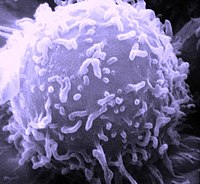
Back جهاز مناعي تكيفي Arabic Qazanılmış immun sistemi Azerbaijani অর্জিত প্রতিরক্ষা Bengali/Bangla རང་སྐྱེད་ནད་འགོག Tibetan Adaptivni imunski sistem BS Sistema immunitari adaptatiu Catalan Aktiv immunisering Danish Επίκτητη ανοσία Greek Adaptive immune system English Sistema de inmunidad adquirida Spanish

The adaptive immune system is made of specialized cells and processes which kill pathogens or prevent their attack.
The adaptive immune system is switched on by the evolutionarily older innate immune system.[1] This older system is non-specific, whereas the adaptive system is tailored to specific targets.
Whereas the innate immune system is found in all metazoa, the adaptive system is only found in vertebrates. It is thought to have arisen in the first jawed vertebrates.[1][2]
The adaptive immune response gives the vertebrate immune system the ability to recognize and remember specific pathogens. The system mounts stronger attacks each time a particular pathogen is encountered. It is adaptive immunity because the body's immune system prepares itself for future challenges.
- ↑ 1.0 1.1 Janeway C.A. 2001. Evolution of the immune system. In Immunobiology ed Janeway et al. 5th ed, 597–607. New York: Garland Science. ISBN 978-0-8153-4101-7
- ↑ Hirano, Masayuki; Das, Sabyasachi; Guo, Peng; Cooper, Max D. (2011-01-01), Alt, Frederick W. (ed.), The Evolution of Adaptive Immunity in Vertebrates, Advances in Immunology, vol. 109, Academic Press, pp. 125–157, doi:10.1016/b978-0-12-387664-5.00004-2, ISBN 9780123876645, PMID 21569914, retrieved 2019-12-03